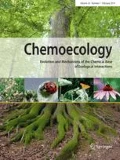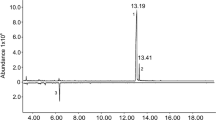Abstract
The yellow-legged clearwing (YLC) Synanthedon vespiformis (Lepidoptera: Sesiidae) occurs in the Mediterranean and central Europe. It is polyphagous, boring into the woody parts of broadleaf species including forest trees as well as various Rosaceae species. S. vespiformis has been reported as an economically important pest causing severe injury to stone fruit plantations. Many attractants for sesiid species were discovered by random field screening using 2,13- and 3,13-octadecadienyl alcohols, acetates and aldehydes, including one for S. vespiformis; and about 20 sex pheromones of sesiids have been identified so far. In the present study we identified the natural composition of the sex pheromone of YLC laboratory reared females as a blend of E3,Z13- and Z3,Z13-octadecadienyl acetates, at a ratio of 4:1. We developed an efficient lure for monitoring the pest. Pheromone funnel traps with rubber septa, impregnated with 1 mg pheromone blend, efficiently captured males for 10 weeks. Suspension of Shin-Etsu® ropes containing a 2:1 blend of E3,Z13-18:Ac and Z3,Z13-18:Ac at 13.74 mg/ha/h, resulted in shutdown of trap catches in the treated plots and closely situated neighboring plots indicating that mating disruption is feasible.




Similar content being viewed by others
References
Audemard H, Vigouroux A (1982) A curious parasitic association on peach trees—Synanthedon vespiformis and bacterial tumor of the fruit top caused by Agrobacterium tumefaciens. Phytoma 336:28–29
Ben Yehuda S, Dunkelblum E, Protasov A, Zada A, Mendel Z (2007) Occurrence of Synanthedon vespiformis (Lepidoptera; Sesiidae) in stone fruit orchards and development of means for its monitoring. Alon Hanotea 61:11–14 (in Hebrew with English abstract)
Buda V, Maeorg U, Karalius V, Rothschild GHL, Kolonistova S, Ivinskis P, Mozuraitis R (1993) C18 Dienes as attractants for eighteen clearwing (Sesidae), tineid (Tineidae), and choreutid (Choreutidae) moth species. J Chem Ecol 19:799–813
El-Sayed AM (2011) Internet database. http://pherobase.com/
Garrevoet T, Garrevoet W, Zbek H (2005) A contribution to the knowledge of the Sesiidae of Turkey (Lepidoptera). Turk J Zool 29:27–28
Gindin G, Kuznetsova T, Protasov A, Ben Yehuda S, Mendel Z (2009) Artificial diet for two flat-headed borers Capnodis spp., Coleoptera: Buprestidae). J Eur Entomol 196:573–581
Halperin J, Sauter W (1991–1992) An annotated list with new records of Lepidoptera associated with forest and ornamental trees and shrubs in Israel. Isr J Entomol 25–26:105–147
Karandinos MG, Tumlinson JH, Eichlin TD (1976) Field evidence of synergism and inhibition in the sesiidae sex pheromone system. J Chem Ecol 3:57–64
Karg G, Suckling DM, Bradley SJ (1994) Absorption and release of pheromone of Epiphyas postvittana (Lepidoptera: Tortricidae) by apple leaves. J Chem Ecol 8:1825–1841
Naka H, Nakazawa T, Sugie M, Yamamoto M, Horie Y, Wakasugi R, Arita Y, Tsuchida K, Ando T (2006) Synthesis and characterization of 3,13- and 2,13-octadecadienyl compounds for identification of the sex pheromone secreted by a clearwing moth, Nokona pernix. Biosci Biotechnol Biochem 70:508–516
Naka H, Horie Y, Mochizuki F, Vang LV, Yamamoto M, Saito T, Watari T, Tsuchida K, Arita Y, Ando T (2008) Identification of the sex pheromone secreted by Synanthedon hector (Lepidoptera: Sesiidae). Appl Entomol Zool 43:467–474
Naka H, Mochizuki M, Nakada K, Do ND, Yamauchi T, Arita Y, Ando T (2010) Female sex pheromone of Glossosphecia romanovi (Lepidoptera: Sesiidae): identification and field attraction. Biosci Biotechnol Biochem 74:1943–1946
Pfeiffer DG, Killian JC, Rajotte EG, Hull LA, Snow JW (1991) Mating disruption for reduction of damage by lesser peach tree borer (Lepidoptera: Sesiidae) in Virginia and Pennsylvania peach orchards. J Econ Entomol 40:218–223
Roelofs WL (1978) Threshold hypothesis for pheromone perception. J Chem Ecol 4:685–699
Szántóné-Veszelka M, Poós B, Szőcs G (2010) Blackberry and raspberry, new hosts of the yellow legged clearwing moth, Synanthedon vespiformis: what can the recently developed sex attractant offer in monitoring and beyond? In: IOBC Working Group, Integrated Plant Protection in Fruit Crops Subgroup “Soft Fruits”, 7th workshop on Integrated Soft Fruit Production, 20–23 September 2010, Budapest, Hungary
Tumlinson JH, Yonce CE, Doolittle RE, Heath RR, Gentry CR, Mitchell ER (1974) Sex pheromones and reproductive isolation of the lesser peachtree borer and the peachtree borer. Science 185:614–616
Voerman S, Audemard H, Priesner E (1983) Sex attractants for clearwing moths: Synanthedon vespiformis and Chamaesphecia tenthrediniformis (and/or C. empiformis). Entomol Exp Appl 34:203–205
Wall C, Sturgeon DM, Greenway AR, Perry JN (1981) Contamination of vegetation with synthetic sex pheromone released from traps for the pea moths, Cydia nigrina. Entomol Exp Appl 30:11–115
Yang CY, Kim J, Kang TJ, Jeon HY (2009) Identification and field bioassays of the sex pheromone of Synanthedon haitangvora. J Chem Ecol 35:1197–1201
Acknowledgments
The study was supported by the Chief Scientist Grant No. 131-1443. We would like to thank Dr. Franz Pühringer (Konrad, Austria) and Prof. Zdeněk Laštůvka (Mendel University, Brno, Czech Republic) for the identification of Synanthedon vespiformis. We thank Dr. Ogawa at Shin-Etsu Chemical Company for providing the pheromones ropes for mating disruption and Prof. Tetsu Ando of Tokyo University for the octadecadienyl acetates standards. We also would like to thank the two anonymous reviewers for their valuable contribution in the improvement of the manuscript.
Author information
Authors and Affiliations
Corresponding author
Rights and permissions
About this article
Cite this article
Levi-Zada, A., Ben-Yehuda, S., Dunkelblum, E. et al. Identification and field bioassays of the sex pheromone of the yellow-legged clearwing Synanthedon vespiformis (Lepidoptera: Sesiidae). Chemoecology 21, 227–233 (2011). https://doi.org/10.1007/s00049-011-0081-7
Received:
Accepted:
Published:
Issue Date:
DOI: https://doi.org/10.1007/s00049-011-0081-7




